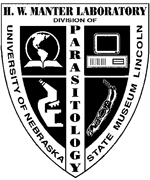Parasitology, Harold W. Manter Laboratory of

Harold W. Manter Laboratory of Parasitology: Library Materials
ORCID IDs
Escalante 0000-0002-1532-3430
Document Type
Article
Date of this Version
2-29-2016
Citation
BMC Ecology and Evolution (2016) 16: 47
doi: 10.1186/s12862-016-0625-0 (includes supplemental materials)
Abstract
Background: Low complexity regions (LCRs) are a ubiquitous feature in genomes and yet their evolutionary history and functional roles are unclear. Previous studies have shown contrasting evidence in favor of both neutral and selective mechanisms of evolution for different sets of LCRs suggesting that modes of identification of these regions may play a role in our ability to discern their evolutionary history. To further investigate this issue, we used a multiple threshold approach to identify species-specific profiles of proteome complexity and, by comparing properties of these sets, determine the influence that starting parameters have on evolutionary inferences.
Results: We find that, although qualitatively similar, quantitatively each species has a unique LCR profile which represents the frequency of these regions within each genome. Inferences based on these profiles are more accurate in comparative analyses of genome complexity as they allow to determine the relative complexity of multiple genomes as well as the type of repetitiveness that is most common in each. Based on the multiple threshold LCR sets obtained, we identified predominant evolutionary mechanisms at different complexity levels, which show neutral mechanisms acting on highly repetitive LCRs (e.g., homopolymers) and selective forces becoming more important as heterogeneity of the LCRs increases.
Conclusions: Our results show how inferences based on LCRs are influenced by the parameters used to identify these regions. Sets of LCRs are heterogeneous aggregates of regions that include homo- and heteropolymers and, as such, evolve according to different mechanisms. LCR profiles provide a new way to investigate genome complexity across species and to determine the driving mechanism of their evolution.


Comments
Open access
License: CC BY 4.0 International